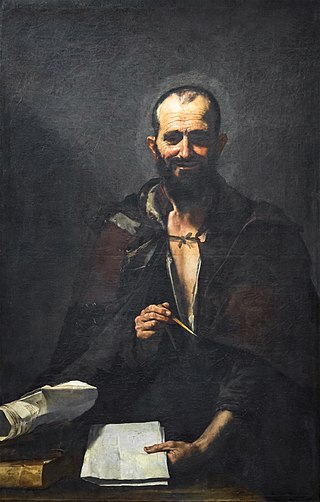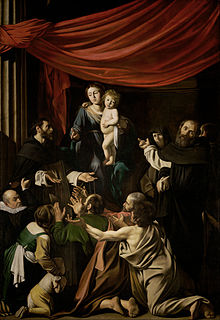
The Museo del Prado, officially known as Museo Nacional del Prado, is the main Spanish national art museum, located in central Madrid. It houses collections of European art, dating from the 12th century to the early 20th century, based on the former Spanish royal collection, and the single best collection of Spanish art. Founded as a museum of paintings and sculpture in 1819, it also contains important collections of other types of works. The numerous works by Francisco Goya, the single most extensively represented artist, as well as by Hieronymus Bosch, El Greco, Peter Paul Rubens, Titian, and Diego Velázquez, are some of the highlights of the collection. Velázquez and his keen eye and sensibility were also responsible for bringing much of the museum's fine collection of Italian masters to Spain, now one of the largest outside of Italy.
Aniello Falcone or Ancillo Falcone was an Italian Baroque painter, active in Naples and noted for his painted depictions of battle scenes.

Guido Reni was an Italian Baroque painter, although his works showed a classical manner, similar to Simon Vouet, Nicolas Poussin, and Philippe de Champaigne. He painted primarily religious works, but also mythological and allegorical subjects. Active in Rome, Naples, and his native Bologna, he became the dominant figure in the Bolognese School that emerged under the influence of the Carracci.

The Caravaggisti were stylistic followers of the late 16th-century Italian Baroque painter Caravaggio. His influence on the new Baroque style that eventually emerged from Mannerism was profound. Caravaggio never established a workshop as most other painters did, and thus had no school to spread his techniques. Nor did he ever set out his underlying philosophical approach to art, the psychological realism which can only be deduced from his surviving work. But it can be seen directly or indirectly in the work of Rubens, Jusepe de Ribera, Bernini, and Rembrandt. Famous while he lived, Caravaggio himself was forgotten almost immediately after his death. Many of his paintings were re-ascribed to his followers, such as The Taking of Christ, which was attributed to the Dutch painter Gerrit van Honthorst until 1990.

Luis de Morales was a Spanish painter active during the Spanish Renaissance in the 16th century. Known as "El Divino", most of his work was of religious subjects, including many representations of the Madonna and Child and the Passion.

Jusepe de Ribera was a Spanish painter and printmaker. Ribera, Francisco de Zurbarán, Bartolomé Esteban Murillo, and the singular Diego Velázquez, are regarded as the major artists of Spanish Baroque painting. Referring to a series of Ribera exhibitions held in the late 20th century, Philippe de Montebello wrote "If Ribera's status as the undisputed protagonist of Neapolitan painting had ever been in doubt, it was no longer. Indeed, to many it seemed that Ribera emerged from these exhibitions as not simply the greatest Neapolitan artist of his age but one of the outstanding European masters of the seventeenth century." Jusepe de Ribera has also been referred to as José de Ribera, Josep de Ribera, and was called Lo Spagnoletto by his contemporaries and early historians.
"Ecce homo", is a phrase traditionally attributed to Pontius Pilate at the trial of Jesus.

Ecce Homo is a painting of the moment known as Ecce Homo from the Passion of Jesus by the Italian Baroque master Caravaggio. It is now in the Palazzo Bianco, Genoa, Italy. Contemporary accounts claim the piece was part of an unannounced competition between three artists, and that the Caravaggio version was eventually sent to Spain.

Jacob's Dream is a 1639 oil-on-canvas painting by the Spanish Tenebrist painter José de Ribera.

Francesc Ribalta , also known as Francisco Ribaltá or de Ribalta, was a Spanish painter of the Baroque period, mostly of religious subjects.

Bartolomeo Cavarozzi (1587–1625), occasionally referred to as Bartolomeo Crescenzi, was an Italian caravaggisti painter of the Baroque period. Cavarozzi's work began receiving increased admiration and appreciation from art historians in the last few decades of the 20th century, emerging as one of the more distinct and original followers of Caravaggio. He received training from Giovanni Battista Crescenzi in Rome and later traveled to Spain alongside his master for a few years where he achieved some renown and was significant in spreading "Caravaggism" to Spain before returning to Italy. His surviving works are predominantly Biblical subjects and still-life paintings, although older references note he "was esteemed a good painter especially of portraits".

Antonio de Pereda y Salgado was a Spanish Baroque-era painter, best known for his still lifes.

Pietro Cussida, Pietro Cuside or Pedro Cossida was a Spanish diplomat in the service of Philip III of Spain and his successor, Philip IV. He was an art collector and patron, known for his patronage of Caravaggisti artists, including Jusepe de Ribera and Dirck van Baburen.

Gabriele Maria Finaldi is a British art historian and curator, with Italian citizenship. Since August 2015, he has been director of the National Gallery in London, England.

Women Gladiators is a painting by Jusepe de Ribera made in oil on canvas. It is conserved in the Museo del Prado, Madrid.

The Martyrdom of Saint Philip is a painting by Jusepe de Ribera from 1639.

Ixion is a 1632 oil painting, signed and dated by Jusepe de Ribera. It shows a scene from Classical mythology, of Ixion being tortured as the eternal punishment meted out by Zeus. It is one of a series of four paintings by Ribera of the four "Furies" or "Condemned" from Greek mythology. It is held by the Museo del Prado in Madrid, along with Ribera's painting of Tityos; the other two, of Sisyphus and Tantalus, are lost.

Democritus is an oil on canvas painting by Jusepe de Ribera, executed in 1630, now in the Museo del Prado, in Madrid. It is believed to depict the Ancient Greek philosopher Democritus.

Saint Didacus of Alcalá Presenting Juan de Herrera's Son to Christ is a c.1606 oil on panel painting by Annibale Carracci, possibly with studio assistance. Probably his last public work, it is now in a chapel of the church of Santa Maria in Monserrato degli Spagnoli in Rome.

The Flagellation of Christ is a c.1618 oil on canvas painting by Jusepe de Ribera, from the start of his stay in Naples. A smaller autograph copy without the accompanying figure on the right is now in the Galleria Sabauda in Turin.



















